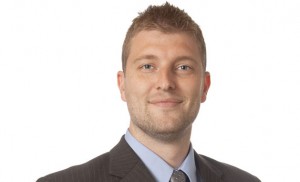Great Plains a great idea for working professionals
Thomas DeJong had a one-year-old son, a full-time job in mortgage lending, and a strong desire to be an independent financial planner.

“By collaborating, there is a dynamic line up of professors. I had some really great professors. My negative experiences were few.†Thomas DeJong, a family financial planning graduate
He found the answer to career development through the Great Plains Interactive Distance Education Alliance, of which SDSU is a member.
It is comprised of eleven public research universities and focuses on graduate programs geared toward the working professional.
A unique feature of Great Plains Interactive Distance Education Alliance classes is that the courses are offered across university lines.
So for one semester, a student may take courses from the University of Nebraska and another semester be a Hawkeye, taking classes from the University of Iowa. All schools have agreed to a per-credit fee of $465, which is more than SDSU would otherwise charge, but less than many other schools charge for online courses.
The degree or certificate comes from the school that the student chooses as its home institution, says Katie Grayson, alliance coordinator at SDSU.
SDSU programs
Students generally select a home institution based on how their interests align with the research background of faculty at each institution. DeJong selected SDSU as his home institution. The following alliance programs are offered through SDSU:
• Dietetics (M.S.)
• Family and Consumer Sciences Education (M.S.)
• Family Financial Planning (M.S. or graduate certificate)
• Financial and Housing Counseling (certificate)
• Merchandising (M.S. or graduate certificate)
• Community Development (M.S.)
• Bioenergy and Sustainable Technology (graduate certificate)
• Grassland Management (graduate certificate)
Two others are in the works for this fall—undergraduate certificates in swine science and ag law certificate. An undergraduate degree in early childhood education is in the planning stages.
SDSU has been part of the alliance since it formed in 1994, but participation was small. In 2000, only three SDSU students were enrolled. Ten years later, there were thirty-four Jackrabbits in the program. In fall 2011, the number was forty-nine with dietetics showing the greatest growth.
Grayson says, “Our dietetics program began with GPIDEA in 2008 with one student and there are currently thirteen students.â€
‘Getting best of best’
She says that one of the alliance’s strengths is “we share the responsibility for teaching. You are getting the best of the best from each institution in each field.
“For example, in swine science SDSU couldn’t afford to get a full staff for a swine science program. Sharing the teaching loads through GPIDEA has allowed us to give students the opportunity to take the courses and still be a part of SDSU. The students are truly getting an expert.â€
DeJong, who found out about the program through an online search, says, “With the Great Plains program, hopefully each institution is putting its most competent and knowledgeable professors forward. You end up with a lot of great teachers.
“It would be hard for one institution to provide ten phenomenal financial planning professors. I doubt there are enough people that want to be financial planners in the Brookings–Sioux Falls area that you could have a master’s program.
“By collaborating, there is a dynamic line up of professors. I had some really great professors. My negative experiences were few. They were very knowledgeable, very competent, very easy to work with and understanding with getting projects in.
“While there are deadlines to meet, when there were extenuating circumstances, most of the professors were very understanding.â€
Program fit evolving life
In fact, in March 2011, when DeJong, of Sioux Center, Iowa, was going to defend his case study, his wife was very sick. So he faced his graduate panel via the phone. “The original plan was to defend my master’s in Brookings, but a few of the professors would have been via teleconference anyway because I had professors from colleges beyond SDSU on my panel,†he adds.
In 2008, DeJong completed the seven classes required to take the exam to be become a certified financial planner.
That was in 2008. “I thought I might as well finish the master’s while I’m at it,†says DeJong, who added two more children and started his own financial planning practice while finishing his master’s degree. This January marked his fourth year in business.
“There are very few financial planners that have a master’s degree. I feel it gives me a leg up on the competition.
“While people won’t come to you because you have m.s. after your name, it certainly makes you a more knowledgeable and competent financial professional as opposed to entering the profession as a rookie with no experience beyond studying for a securities or insurance license.
“I encourage people to get the education first before they jump into the profession, where they might not be ready. Lack of education is one reason the turnover rate in our business is so high,†DeJong says.
Dave Graves






